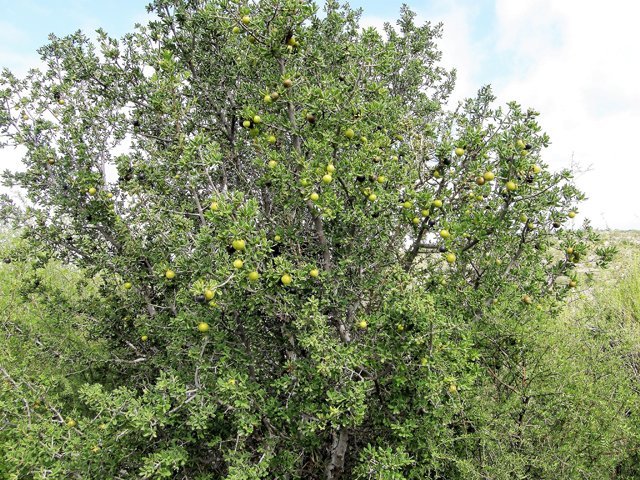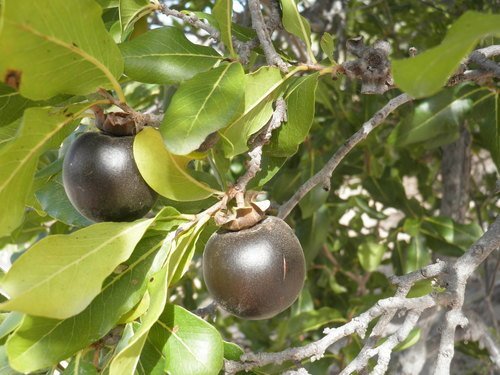Texas Persimmon
Diospyros texana
Family: Ebanaceae
OTHER NAMES
Mexican persimmon, black persimmon
Spanish: chapote, chapote prieto, chapote manzano
The word Spanish word chapote is derived from the Nahuatl word tzapotl, a word that refers to several fruit-bearing trees in Mexico.
CHARACTERISTICS
Small evergreen tree, 15’h&w, but can get taller. Plants can be deciduous in cold regions. Small, nectar rich flowers appear in spring. Plants are dioecious (separate male and female plants) so you need to ensure you have both sexes if you want fruit. The female tree produces a round, one-inch fruit that starts out green and ripen to black by late July to September. The trunks become mottled and peeling with age—very attractive.
There are several species of Diospyros that are native in the southern USA and northern Mexico that can probably be grown in our region. See below.
Photo of Diospyros texana by Wynn Anderson, Lady Bird Johnson Wildflower Center
LANDSCAPE USE
Screening shrub or small tree.
GROWING CONDITIONS
Full to part sun, moderate water, hardy to 15°F.
GROWING CONDITIONS
AN EXPLANATION OF TERMS USED
SUN full to part sun
WATER moderate to low
SOIL well-drained
HARDINESS hardy to about 15°F
BASIN high zone
CONTAINER does ok in containers
NUTRITION low to moderate
MAINTENANCE little
ECOLOGY
Nectar rich flowers appear in spring and provide for bees and butterflies. This is a larval host for the gray hairstreak, fruit edible for humans, birds and mammals. Many insects and animals use the fruit for food.
ETHNOBOTANY
The fruit is edible and can be made into preserves or syrups. They are small so it takes a bit to make preserves or used in pudding or custards. The juice used as a dye. The sapwood of Texas persimmon is clear yellow, while the heartwood, found only in very large trees, is black (ebony), like that of the related D. ebenum. The heartwood is hard and dense and takes a high polish. It is used to make engraving blocks, artwork, and tools.
NATURAL DISTRIBUTION
Native to rocky, open woodlands, slopes & arroyos in Texas (in the Rio Grande Plains, Edwards Plateau, and the southeastern corner of the Trans-Pecos region), and south into Mexico (northern portions of Neuvo Leon, Coahuila, Tamaulipas, and the extreme northeastern part of Chihuahua.
TAXONOMY AND NAME
This species is in the Ebanaceae, the Persimmon family. There are 742 species of Diospyros native to the tropics worldwide, with only a few species extending into temperate regions..
The generic name Diospyros comes from a Latin name for the Caucasian persimmon (D. lotus), derived from the Greek dióspyros, from diós and pyrós. The Greek name literally means "Zeus's wheat" but more generally intends "divine food" or "divine fruit". The species, texana, refers to where it is commonly found, Texas.
Diospyros texana on iNaturalist
Diospyros texana on Ladybird Johnson Wildflower Center
The bark naturally peels off to expose a mottled trunk. Photo by Gary Rogers, iNaturalist
Looking under a mature specimen, photo by Debbie M. Giroux, iNaturalist
Flowers ripen to blackish purple, photo by Zach DuFran, iNaturalist
Plants are dioecious (separate male and female-flowering plants). Female flower on the left, male flower on the right, photo by Douglas Goldman, iNaturalist
The Sonoran Persimmon (Diospyros sonorae) is native to Sonora in dry tropical deciduous forest and thornscrub. Its fruits turn yellow when ripe. Photo by Miguel Gastelum, iNaturalist
The Baja Chocolate Sapote (Diosypros californica) is from Baja California is one of the sweetest of the black fruiting persimmons. Photo by Jose Luis Leon de la Luz, iNaturalist
The Cape Wild Persimmon (Diospyros intricata) has sweet honey-like fruits and is very arid-growing. From southern Baja California. Photo by Jim Riley, iNaturalist








